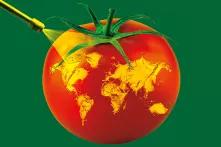
Genetically modified crops were supposed to reduce the use of chemicals in agriculture, reduce workloads, and increase crop yields. These promises could not be kept.

More often than any other substance, glyphosate has been at the center of many controversial debates about pesticides in recent years. In 2017, EU Member States had voted to extend the license for the herbicide for at least five years, despite cautionary voices and demonstrations in numerous countries. How does the herbicide actually work? In short: Glyphosate is applied to food and nonfood field crops such as soybeans and field maize. Glyphosate inhibits the EPSPS enzyme, which is required in plants for the production of vital amino acids. This interrupts the metabolism – and the plant dies. Genetically modified crops are protected against this interruption of the metabolism and can therefore continue to produce amino acids and survive despite sprays. For this reason a genetically modified soybean in its growth phase can be treated with glyphosate without being harmed – while all surrounding plants, that compete with it for water, space and nutrients, die. In times before genetic modification, competing plants usually had to be controlled either by pre-emergence herbicide application, by crop rotation or manual weeding.
Today, 74 percent of soybeans grown worldwide are genetically modified. The increased use of genetically modified organisms (GMO) has been associated with a massive increase in glyphosate use. From 1995 to 2014 the agricultural use of glyphosate in the US rose ninefold, reaching 113,000 tonnes per year – one-third of the total amount of herbicides applied. From 2012 to 2016 an average of approximately 127,000 tonnes of glyphosate were applied to 120 million hectares annually. Most glyphosate was applied to soybeans (53,000 tonnes), maize (43,000 tonnes) and cotton (9,000 tonnes). Globally, the total use of glyphosate rose almost 15-fold, from 51,000 tonnes in 1995 to 747,000 tonnes in 2014. This increase correlates with the expanded cultivation of GM soy in Latin America. After its introduction in Argentina in 1996, the glyphosate volume there had doubled within just one decade. In Brazil, herbicide use in soybean cultivation tripled from 2002 to 2012 to 230,000 tonnes per year, mainly due to glyphosate. Despite the drastic increase in herbicide rates applied, yields per hectare increased by only about 10 percent. Brazil and Argentina are now among the countries with the highest herbicide consumption in the world, in third and fourth place globally after China and the USA.
Intensive use of glyphosate has led to the appearance of glyphosate-resistant weed species worldwide. First reports from Delaware, USA, made global headlines in the year 2000. They found that the Canadian horseweed could no longer be controlled with glyphosate. By 2012, herbicide resistant weeds have already spread across 25 million hectares of arable land in the United States. There are now 53 weed species that have developed glyphosate resistance, including amaranths in cotton and soybean crops. In order to combat such weeds less sensitive to glyphosate, farmers have increased glyphosate application rates and the use of other herbicides was intensified again as well.
Another genetic modification intended to contribute to pesticide reduction was the insertion of specific DNA sequences into crop plants to enhance their resistance to insect pests: A gene transfer from the bacterium Bacillus thuringiensis leads to the formation of proteins known as Bt toxins in the plants. Those proteins are lethal to several types of insects. Insect-resistant crops were cultivated in the mid-1990s for the first time, nowadays they make up 57 percent of all genetically modified crops grown around the globe, predominantly maize and cotton. The fact that plant-incorporated toxins in all parts of the plant act as insecticides throughout the entire vegetation period has consequences for the environment. For example, butterflies and other insects can be harmed. And just like the weeds in soybean cultivation, pests also develop resistance.
In the USA, specimens of the Western corn rootworm are already resistant to more than one Bt toxin. At the beginning of Bt crop cultivation, the number of pesticides used actually decreased. But only impermanently: Sales of insecticides in corn production in the US have increased significantly. In 2018, Indian farmers spent 37 percent more money per hectare on insecticides than before the introduction of genetically modified cotton in 2002. In addition, the cost of seed and fertilizer increased.
These complaints are not new: Already more than ten years ago, twenty civil society organizations from India, South Africa and all over the world stated in their declaration “A Global Citizens Report on the State of GMOs” that genetic engineering has failed to increase food crop yields but has vastly increased herbicide use and the growth of resistant weeds. While big companies gaining seed market control and pushing up prices, farmers have to go into debt. The high levels of indebtedness among farmers is, for example, thought to be behind many of the hundreds of thousands deaths by suicide of Indian farmers over the past years.
